Speaker
Description
Ultra-high-energy cosmic rays (UHECRs) are studied with giant ground-based detectors recording extensive air showers, cascades of secondary particles, induced by cosmic ray particles in the atmosphere. Research at the Pierre Auger Observatory - the largest of such detectors ever built - largely contributed to a number of breakthroughs and dramatically advanced our understanding of UHECRs. Nonetheless, the results so far are still inconclusive as neither have the sources of these most energetic particles known in the Universe been determined, nor has the origin of the unambiguously established cosmic ray flux suppression above 40 EeV been fully understood. At the same time, precise measurements of the muon component of the extensive air showers on the ground show discrepancies with the predictions of hadronic interaction models. The explanation of these puzzles, which are closely related to each other, is one of the most important goals of modern astrophysics.
The results obtained by the Pierre Auger Observatory indicate that further advances in the understanding of UHECRs require an improvement of the measuring capabilities of existing detectors, where the key feature is a superior separation of the muonic and electromagnetic components of air showers. AugerPrime, the ongoing upgrade of the Pierre Auger Observatory has been designed for this task. As part of the upgrade, almost all of the 1661 water-Cherenkov detectors, composing the 3000 km2 of the surface array of the Observatory, will be instrumented with additional scintillator and radio detector units. Moreover, new, faster and more precise acquisition electronics will be installed in all surface detectors. The main objective of the AugerPrime is to enhance the sensitivity of our analyses to the masses of cosmic rays, which will help to elucidate the origin of the UHECRs. In this talk we overview the main features of the AugerPrime design, its current status, and discuss the goals and potential capabilities of the upgraded Observatory.
Details
Jaroslaw Stasielak for the Pierre Auger Collaboration
| Is this abstract from experiment? | Yes |
|---|---|
| Name of experiment and experimental site | Pierre Auguer Observatory |
| Is the speaker for that presentation defined? | Yes |
| Internet talk | No |
